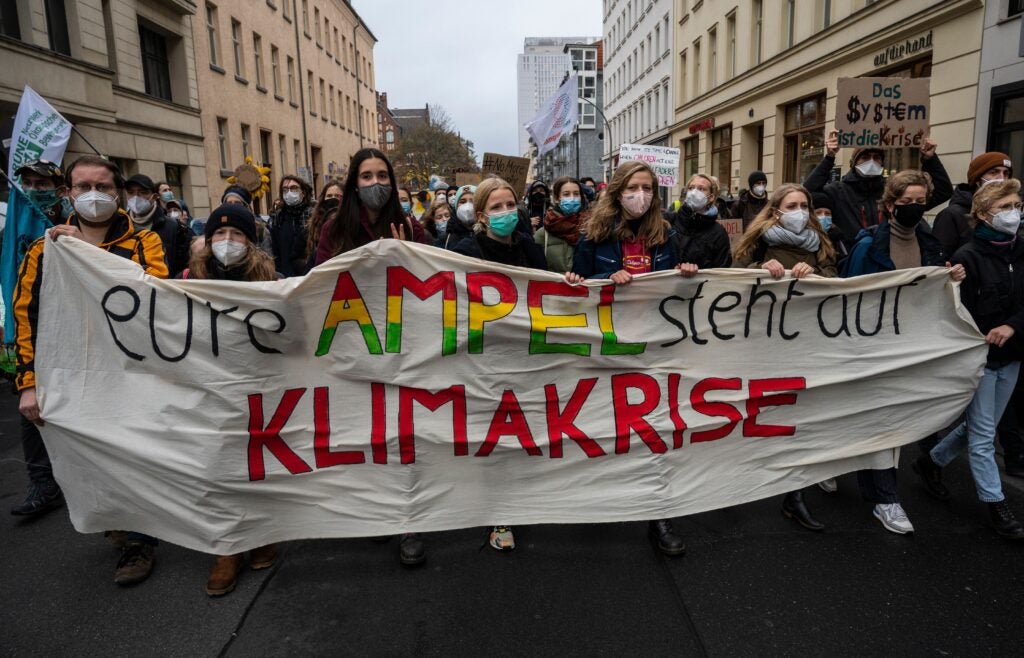After 16 years of Angela Merkel, all eyes were on Olaf Scholz and his ‘traffic light coalition’ (Ampelkoalition) last autumn. After a turbulent first year in which the government has had to deal with a brutal war very close to home, a nadir in relations with long-standing gas supplier Russia, nearly a million Ukrainian refugees, and soaring energy prices and inflation, Energy Monitor examines what Germany’s Ampelkoalition of SPD (Social Democrats), Greens and FDP (liberals) has achieved on the energy transition following its ambitious climate targets.
Energy Monitor’s weekly data, based on think tank DIW Berlin’s ‘Open Energy Tracker’, shows that Germany is mostly not on track to meet its 2030 energy transition targets. “There is a large gap between the current status and the government’s targets for 2030 for most of the indicators considered,” says DIW Berlin.
Onshore wind development is an outlier as 50% of the wind power installations needed to reach the 2030 targets already exist. This stands in stark contrast to other renewable energy technologies such as solar PV and offshore wind, where only approximately a quarter of the targeted installations have so far been deployed – and much of that was built before the start of this decade. Since the start of the Ampelkoalition’s mandate, nearly 5.5GW of solar PV, 1.7GW of onshore wind and 0.20GW of offshore wind have been installed.
Hydrogen is arguably the weakest of the indicators measured by Open Energy Tracker – Berlin has reached only 0.7% of hydrogen electrolysis deployment as part of its 2030 target of around 10GW. This value in turn represents a quarter of the EU’s goal of 40GW of electrolyser capacity by 2030; if Germany is not on track, Europe is not on track.
According to data from Energy Monitor’s parent company, GlobalData, Germany’s current active electrolyser capacity stands at just 55MW. Open Energy Tracker estimates that to reach the 2030 target, the country must add 90MW of electrolyser capacity each month.

Why Germany is not on track to meet its energy transition targets
Germany's new government has met with an unforeseen challenge: Russia’s war in Ukraine. This has led to a cluster of short-term crises. As in the rest of Europe, German industry and households have struggled with rising energy prices and subsequent inflation. The German government will introduce a price cap on electricity for both individual and industrial consumers from 2023, as part of a €200bn national energy emergency plan that has led to accusations that Germany is saving its own skin.
German leaders have also extended the life of the country's nuclear fleet, come under pressure to revive its coal plants and started constructing liquefied natural gas import terminals.
Simultaneously, the government has raised its target for renewables in the electricity mix from 65% to 80% for 2030, updating the EEG 2021 law (Erneuerbare-Energien-Gesetz/Renewable Energy Sources Act) in December 2021, before the war started in Ukraine. The current share is 42%, which means that renewables must double their market share in less than a decade.
However, renewables deployment has been much slower than it needs to be to reach the 2030 target. A key hurdle for German wind power has been the slow and complicated permitting process, with Germany having six times more wind capacity in permitting than under construction.
Solar presents an equally great challenge. Nearly a third of the solar PV installations needed to reach the 2030 target are already online, but these have been built over many years. The reality is that there are currently around 58GW deployed against a target of 215GW for 2030. Open Energy Tracker estimates this means around 1.5GW net of solar panels must be deployed each month, or three times more than what was deployed in 2022 and five times more than what was deployed every year from 2017 to 2021.
However, the data also shows a major leap forward in German energy policy – the 215GW solar PV goal for 2030 is more than four times what the 2030 target was as recently as 2020 (54GW). The big leap forward came before Russia’s invasion of Ukraine, but the solar PV goal has been raised by another 15GW since then.
Since the war started, Germany has also introduced tax breaks for small-scale PV systems and cut back on bureaucratic hurdles to their roll-out. Owners of solar PV installations of up to 30kW will be exempt from paying income tax on them, and the delivery and installation of the solar PV systems will not be taxed under VAT in certain circumstances.
The war in Russia has left German energy policy at a crossroads and it has upped the ante of the energy transition. However, despite efforts to accelerate the roll-out of renewables, the data shows that Germany is not on track to meet the energy transition targets its new government set back in autumn 2021.



